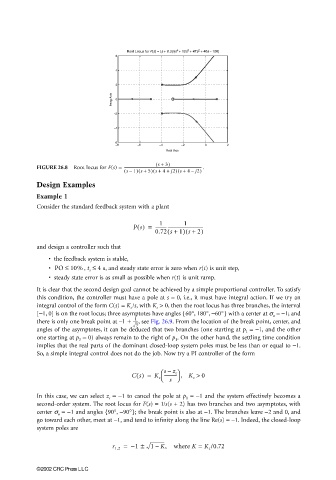Page 825 - The Mechatronics Handbook
P. 825
066_Frame_C26 Page 10 Wednesday, January 9, 2002 1:59 PM
4
3
2
Root Locus for F(s) = (s + 0.3)/(s + 12s + 47s + 40s − 100)
6
4
2
Imag Axis 0
−2
−4
−6
−8 −6 −4 −2 0 2
Real Axis
( s + 3)
FIGURE 26.8 Root locus for F(s) = --------------------------------------------------------------------------------------- .
( s – 1) s + 5) s ++( 4 j2) s + 4 – j2)
(
(
Design Examples
Example 1
Consider the standard feedback system with a plant
1
1
Ps() = ------------------------------------------
0.72 s + 1) s + 2)
(
(
and design a controller such that
• the feedback system is stable,
• PO ≤ 10% , t s ≤ 4 s , and steady state error is zero when r(t) is unit step,
• steady state error is as small as possible when r(t) is unit ramp.
It is clear that the second design goal cannot be achieved by a simple proportional controller. To satisfy
this condition, the controller must have a pole at s = 0, i.e., it must have integral action. If we try an
integral control of the form C(s) = K c /s, with K c > 0, then the root locus has three branches, the interval
[−1, 0] is on the root locus; three asymptotes have angles {60°, 180°, −60°} with a center at s a = −1; and
1
there is only one break point at 1 +– ------- , see Fig. 26.9. From the location of the break point, center, and
3
angles of the asymptotes, it can be deduced that two branches (one starting at p 1 = −1, and the other
one starting at p 3 = 0) always remain to the right of p 1 . On the other hand, the settling time condition
implies that the real parts of the dominant closed-loop system poles must be less than or equal to −1.
So, a simple integral control does not do the job. Now try a PI controller of the form
–
----------- , K c >
Cs() = K c sz c 0
s
In this case, we can select z c = −1 to cancel the pole at p 1 = −1 and the system effectively becomes a
second-order system. The root locus for F(s) = 1/s(s + 2) has two branches and two asymptotes, with
center σ a = −1 and angles {90°, −90°}; the break point is also at −1. The branches leave −2 and 0, and
go toward each other, meet at −1, and tend to infinity along the line Re(s) = −1. Indeed, the closed-loop
system poles are
r 1,2 = – 1 ± 1 K, where K = K c /0.72
–
©2002 CRC Press LLC

